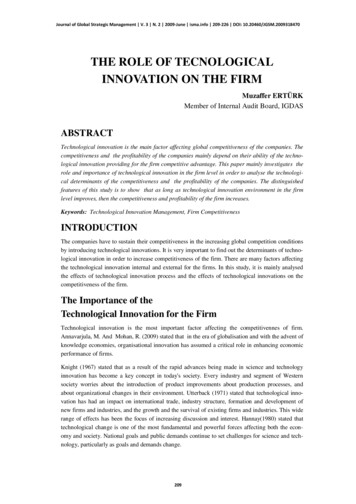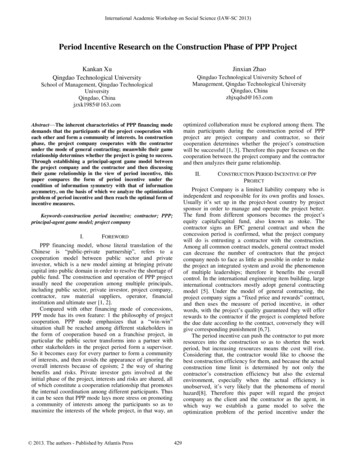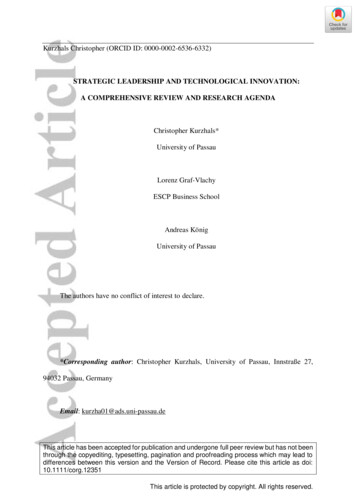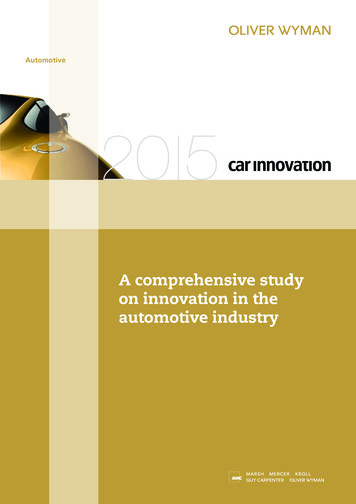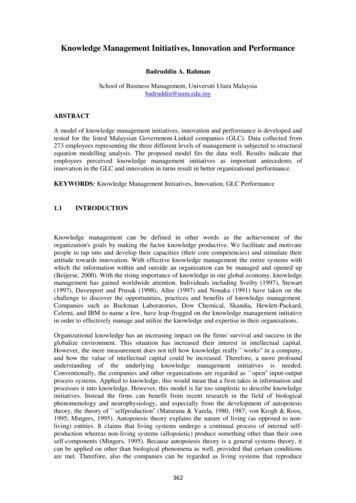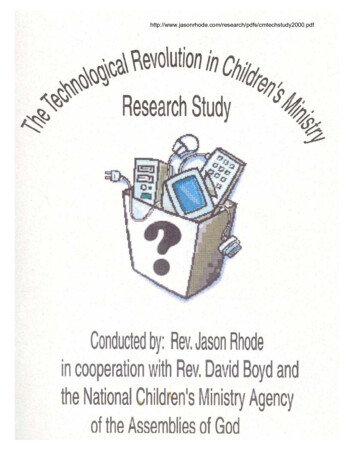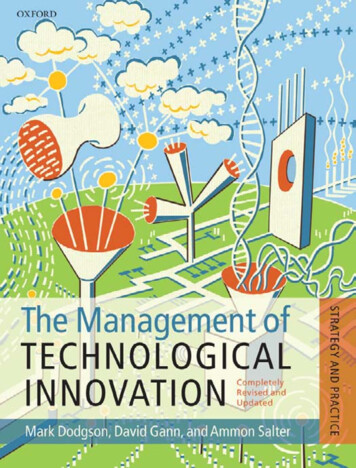
Transcription
The Management of Technological InnovationStrategy and PracticeCompletely Revised and Updated
This page intentionally left blank
The Management ofTechnological InnovationStrategy and PracticeCompletely Revised and UpdatedMark DodgsonDavid GannAmmon Salter1
3Great Clarendon Street, Oxford ox2 6 Oxford University Press is a department of the University of Oxford.It furthers the University’s objective of excellence in research, scholarship,and education by publishing worldwide inOxford New YorkAuckland Cape Town Dar es Salaam Hong Kong KarachiKuala Lumpur Madrid Melbourne Mexico City NairobiNew Delhi Shanghai Taipei TorontoWith offices inArgentina Austria Brazil Chile Czech Republic France GreeceGuatemala Hungary Italy Japan Poland Portugal SingaporeSouth Korea Switzerland Thailand Turkey Ukraine VietnamOxford is a registered trade mark of Oxford University Pressin the UK and in certain other countriesPublished in the United Statesby Oxford University Press Inc., New York Oxford University Press 2008The moral rights of the authors have been assertedDatabase right Oxford University Press (maker)First published 2008All rights reserved. No part of this publication may be reproduced,stored in a retrieval system, or transmitted, in any form or by any means,without the prior permission in writing of Oxford University Press,or as expressly permitted by law, or under terms agreed with the appropriatereprographics rights organization. Enquiries concerning reproductionoutside the scope of the above should be sent to the Rights Department,Oxford University Press, at the address aboveYou must not circulate this book in any other binding or coverand you must impose the same condition on any acquirerBritish Library Cataloguing in Publication DataData availableLibrary of Congress Cataloging in Publication DataDodgson, Mark, 1957–The management of technological innovation / Mark Dodgson, David Gann, Ammon Salter. — 2nd ed.p. cm.Includes bibliographical references and index.ISBN 978–0–19–920853–1 — ISBN 978–0–19–920852–4 1. Technological innovations—Management.2. Research, Industrial—Management. I. Gann, David. II. Salter, Ammon. III. Title.T173.8.D62 20082007028407658.4 062–dc22Typeset by SPI Publisher Services, Pondicherry, IndiaPrinted in Great Britainon acid-free paper byAntony Rowe Ltd., Chippenham, WiltshireISBN 978–0–19–920852–4 (hbk.)ISBN 978–0–19–920853–1 (pbk.)10 9 8 7 6 5 4 3 2 1
ENDORSEMENTSThis is an outstanding book which gives the management of innovation its rightful rolein understanding of modern capitalism and its restless nature. Everyone who is interestedin the theory and practice of technological innovation should place this book on theirreading list.Prof Stan Metcalfe, University of ManchesterThe Management of Technological Innovation brings the role of design into the heart ofthe innovation process, enabling students from a wide range of disciplines to understandhow to integrate and manage product and service innovation.Prof Andrew Hargadon, University of California (Davis)Dodgson, Gann, and Salter have written the first indispensable innovation textbookfor the 21st century. It combines advanced tools and techniques on managing open,distributed innovation processes along with the latest on intellectual property and publicpolicy.Prof Hank Chesbrough, Haas School of Business, UC BerkeleyThis is a valuable addition to the bookshelf for those—students and practitioners alike—interested in how to manage innovation. With its emphasis on dealing with this key issuein strategic fashion and plenty of up-to-date case material it offers an excellent resourcefor courses in the subject.Prof John Bessant, Imperial College LondonThis is a very comprehensive and useful textbook that provides the essential tools formanaging innovation in a dynamic and changing business context.Prof Franco Malerba, Bocconi UniversityThe Management of Technological Innovation is a very comprehensive and well-writtensurvey of the state of the art in this exciting field. The book provides students witha refreshingly clear strategic perspective and includes practical cases from around theworld. Dodgson, Gann, & Salter’s work will doubtless play an important role in thetraining of the next generation of strategists and managers.Prof Christopher Tucci, EPFL, SwitzerlandThe Management of Technological Innovation is an excellent course book drawingtogether all the elements needed to succeed in the innovation process from creativeintent to commercial realisation.Prof Dorothy Leonard, Harvard Business School
viENDORSEMENTSThis textbook embodies the managerial tasks of building innovation and technologystrategies, organizing and leveraging people’s skills and expertise within and across firms.It helps students appreciate these essential managerial practices to enable value creationthrough innovation.Prof Deborah Dougherty, Rutgers UniversityThere is great need for a comprehensive textbook on the management of technologicalinnovation. This book provides an excellent introduction to the innovation process andthe strategies needed to manage it.Prof Michael Cusumano, MIT Sloan School of ManagementStudents in a wide range of design disciplines will turn to this book to understand theessential role of design in relation to product and service innovation.Prof Jeremy Myerson, Royal College of ArtThis welcome new textbook is distinguished by the range and freshness of the caseexamples, which span the traditional manufacturing/services divide, and by its rigoroustreatment of the challenges of innovation management in global markets.Prof Alan Hughes, University of CambridgeThe Management of Technological Innovation combines relevant case studies with valuable insights to offer a coherent argument for the strategic management of innovation.A valuable book packed with tools and techniques to help put ideas into practice.Prof Andy Neely, Deputy Director of Advanced Institute forManagement Research, Cranfield School of ManagementThis textbook provides a robust framework for understanding the interconnectionsbetween national and regional design and innovation systems and the internationalisation of production and markets.Prof Kevin Morgan, Cardiff UniversityIt is refreshing to see such an international approach taken in this book, to bring homethe fact that nations continue to matter in formulating innovation strategy.Prof Mari Sako, Said Business School, Oxford UniversityIn the fast-changing, hyper-competitive, global world we live in, innovation is criticalnot only to the health of every business but to its very survival. Yet, managers generallylearn how to effectively deal with innovation ‘on the job’, sometimes successfully—oftenmuch less so. ‘The Management of Technological Innovation—strategy and practice’ isan excellent account of the main tools and techniques involved in managing 21st Centuryinnovation processes. It is essential reading for anyone getting a business degree as wellas those on executive courses.Irving Wladawsky-Berger, VP, Technical Strategy and Innovation, IBM
ENDORSEMENTSviiAn excellent synthesis of the multiple dimensions involved in managing technologicalinnovation. It provides practical techniques and essential case studies for those oncorporate management development courses.Lem Lasher, Chief Innovation Officer, Computer Sciences CorporationThis textbook provides the foundations for managing innovation in a wide range ofbusinesses and organisations, ending with an inspiring set of future challenges aboutenvironmental sustainability, corporate responsibility and the role of government—which all managers should be thinking about.Baroness Denise KingsmillManaging technological innovation is part craft, part science. This textbook captures theessential features in a highly readable format.Mike Phillips, Head of Applied Technologies, McLarenThe idea of management of technological innovation presents a most valuable contribution to companies. Visionary strategies and progressive practices illustrated in this bookprovide useful techniques and tools for innovators, researchers and students.Yusuke Yamazaki, General Manager, Institute of Technology, Shimizu CorporationNot only is this an excellent text for students, it also provides deep practical understanding for managers in business.Malcolm Skingle, Director, Academic Liaison, Worldwide Business Development, GSKFirms will find this accessible book an invaluable source for their professional development programmes.Dr John Miles, Director and Chairman, Global Consulting Services, ArupDelivering successful and sustainable innovation is a goal for all world-class businesses.While innovation can be complex and challenging, it brings a multitude of rewards thatfew other business endeavours could. This textbook articulates the essential contributionof design thinking in achieving this goal.Mat Hunter, Director, IDEOMost business leaders acknowledge the critical role that technology and innovationplay in the success of their organisation’s activities. But taking full advantage of theopportunities offered by technology, in a continuous and systematic way, has proven tobe an elusive skill. By bringing together theory and practice from a variety of industries,this book enables managers and researchers to get a real head start in harnessing thepower of innovation.Humza Malik, Group Strategy and Corporate Development Director, National Grid plc
viiiENDORSEMENTSThis book provides an essential reference point for students and those on executivedevelopment courses, showing how managing innovation unlocks future prosperity—aswell as creating fun and vibrancy in the workplace.Ray O’Rourke, Chairman, Laing O’Rourke plcInnovation is a well-used phrase, meaning many things to different people. But managing technological innovation is essential for the success of most growing businesses. Thisbook aims to clarify definitions and provides engineers, scientists and business studentswith essential information and approaches that will enable them to enhance their owninnovative thinking, in a broad range of markets and activities.Dr Alison Hodge, University Partnerships Director, QinetiQThe creation and management of intellectual property is a key part of the innovationprocess. This book shows clearly how creative approaches to intellectual property willdeliver value through innovation for both the customer and the company.Ian Harvey, Chairman, Intellectual Property InstituteManaging the development of new products and services is the future life-blood forevery organisation. This textbook equips students with all the core elements required tounderstand how to deliver value and create new markets.Bronwyn Curtis, Head of European Broadcasting, BloombergThe management of technological innovation is a fundamental issue for executives incompanies large and small. This book will provide a useful reader for all those onexecutive development courses.Ian Coleman, Global Head, Valuation and Strategy, PricewaterhouseCoopersTechnological innovation creates value for firms in all industries. This book articulateshow the process of delivering that value can be realised.Dr Robert Easton, Managing Director, Carlyle GroupTechnological innovation is fun, generally expensive and risky. The management of it isan art and this book gives a good insight into it.Keith Clarke, Chief Executive, Atkins plc
For Chris Freeman
PREFACEThe management of technological innovation (MTI) is one of the most importantand challenging aspects of contemporary business. As technological innovation is afundamental driver of competitiveness for firms in a wide variety of business sectors,it is essential that the strategies and practices of MTI are well understood.This book describes and analyses these strategies and practices. It examines the waysthey create and deliver value for firms through innovation networks and communities,research and development (R & D), innovation in products, services, operations andprocesses, and the commercialization process. It examines the high levels of complexityand risk associated with MTI. While MTI is one of the most important aspects ofmanagement, it is also one of the most difficult.Although the primary focus of the discussion is the firm, many of the issues addressedin this book apply to other organizations—public or private—that are concerned withinnovation. Efficiency, productivity, and sustainability are the concern of managers in allorganizations.Throughout the book, the particular aspects of MTI are discussed in the context ofthe general environment in which businesses are operating—an environment that isextraordinarily dynamic. The organization and structure of industry and business arebeing transformed; firms and their technology are increasingly becoming integrated intovarious networks and systems; management philosophies and practices are altering withincreased focus on issues such as learning, knowledge, and trust; the innovation processitself is changing with the use of new electronic media; and globalization is having agreater impact on management practices. All these changes impact upon MTI.What differentiates this volume from other books on MTI is, first, its breadth ofcoverage. It examines a broader range of aspects of MTI than the majority of books in thefield, moving from the management of basic science to operations, from consideration ofinnovation strategy to design. It considers some issues from a theoretical perspective—especially within a Schumpeterian framework—and others from the practical point ofview of ‘what is the best way of managing this?’ It is firmly based in the view that goodpractice depends on good theory.Second, it is international in focus. The vast majority of books on this subject takea US perspective (and a US large-firm perspective). However, innovation developmentand diffusion are essentially international activities, and innovative firms usually havean international focus either because they sell products and services overseas, and/orbecause they work with foreign suppliers and partners. This book draws on best practice
PREFACE xifrom across the world. Permanent, sustained, corporate advantage depends upon learning about the best management practices available internationally—found in firms inthe UK, the USA, Taiwan, Italy, Korea, Japan, Israel, Australia, or elsewhere—and understanding that there are always better ways of doing things and improvements to be made.No one country has a monopoly on good ideas, and it would be a mistake to believe thatany particular international model of management has all the answers for MTI. This isimportant, as many of the most pressing challenges for the future of MTI relate to itsinternational management.Third, as well as examining the activities of large firms, in this book we discussMTI in small and medium-sized firms. These firms are important sources and usersof technological innovation, and the challenges and opportunities they face are oftendifferent from those that confront larger firms.Fourth, many of the issues discussed are applicable to both manufacturing and servicecompanies. The boundary between the two is becoming increasingly blurred, and MTIbest practices found in one sector can often be successfully transferred to others.Fifth, in an area where there seems to be an obsession with using only the most upto-date material, the book integrates analyses and research findings from the 1950s tothe present. A great deal of insightful and useful research into MTI tends to be ignoredbecause it is deemed to be out of date and not applicable to present circumstances. Wehold the view that much of this older research is still relevant.Sixth, the book is not driven by the desire to provide simple answers to the problemsof MTI or to promote a particular management technique. There are no recipes for successful MTI; it is a difficult and idiosyncratic process. Some of the techniques that havebeen followed in the past with evangelical zeal, such as business process re-engineeringand total quality management, have been marketed as providing all the answers. Sometools and techniques have a role to play in MTI, but they are not the whole solution. Thereal picture, as we shall see, is much more complex.Seventh, the book takes a strategic approach to MTI. It shows how many of the toolsand techniques used in the management of R&D, new product and service development,operations and technological collaboration cannot be fully effective unless they areguided by a strategy. Such a strategy has to be informed by an understanding of the broadchanges taking place in industry and business, and the book locates MTI in the context ofthe resulting challenges. As technological innovation is an evolving and often uncertainprocess, the book describes why many common approaches to business strategy cannotbe used effectively by innovative firms.The book is structured in three major sections. Part 1 (Chapters 1–3) defines MTIand examines the broad context and forms in which technological innovation occurs.Chapter 1 examines what MTI encompasses by using a number of composite case studiesto illustrate the challenges facing innovative firms. Chapter 2 analyzes some of the
xiiPREFACEmajor contextual and environmental changes occurring in contemporary business andmanagement that influence MTI. Chapter 3 studies technological innovation in depth,considering different types, levels, sources, and outcomes.Part 2 (Chapters 4–9) looks at ways MTI helps create, shape, and deliver innovationfor firms. A number of approaches, tools, and techniques for managing these areas aredescribed, including those that help firms decide what to do in innovation and thosethat help implement their decisions. These chapters commonly accentuate the importance of innovation strategy for effectively building company competitiveness. Chapter 4highlights the difficulties of analysing and developing innovation strategies, but emphasizes their importance and describes how they can be formulated and implemented.Chapter 5 examines the role of innovation communities and networks in supportinginnovation, and management of technological collaborations among limited numbersof firms. Chapter 6 considers R & D, and how it is most effectively managed. Chapter 7addresses innovation in products and services, and Chapter 8 innovation in operationsand processes. Chapter 9 is concerned with the ways firms deliver value from innovationin the market for product and services and the market for ideas.Part 3 comprises a single chapter (10), which concludes with an examination of thefuture challenges of MTI. It argues that these challenges need to be addressed by firms,governments, research organizations, public interest groups, and informed citizens.Case studies are used throughout the book to illustrate key issues and themes. Theseare presented in the text and in a series of boxes, which can be read as stand-alone items.This book is a completely revised and rewritten version of an earlier book by MarkDodgson. Since publication of the original book in 2000, Mark Dodgson, David Gann,and Ammon Salter have been actively researching together (see, e.g., Think, Play, Do:Innovation, Technology, and Organization, Oxford University Press, 2005), and have codeveloped a wide range of teaching material in MTI for a variety of degree programmes:Master of Business Administration, Master of Management, Master of Technology andInnovation Management, final year undergraduate Business and Engineering degrees,and executive programmes. Extensive new teaching and research material is includedin this edition. It has been developed and tested on groups of excellent students andcompanies across the world. Our students’ world views, experiences, and future careeraspirations, their enthusiasm, insights, and internationalism have inspired this book. Wehope it reflects their ideals and will be a guide for their successors.The authors wish to acknowledge those academics and business people who have generously given of their time and knowledge and contributed substantially to the substanceof this book. We are particularly grateful to Virginia Acha, Erkko Autio, James Barlow,John Bessant, Catelijne Coopmans, Paola Criscuolo, Linus Dahlander, Ben Dankbaar,Andy Davies, Gabriela Dutrénit, Lars Frederiksen, Elizabeth Garnsey, Annabelle Gawer,Andrew Griffiths, Alan Hughes, Tim Kastelle, Keld Laursen, Nick Leon, Ian Mackenzie,Orietta Marsili, Pascale Michaud, Ritsuko Ozaki, Nelson Phillips, Jaideep Prabhu, Toke
PREFACE xiiiReichstein, Jonathan Sapsed, Tony Sheehan, John Steen, Florian Taeube, Bruce Tether,Jennifer Whyte, Tim Venables, and Marina Zhang. We thank Mikko Paananen andVandana Ujjual for their research assistance.The planning of the book began in Collorgues in Languedoc-Roussillion, France,and we are very grateful to Jeff and Julie Rodrigues for their generous hospitality andthe numerous surrounding caves for their agreeable sustenance. Parts of the book werewritten in Sidmouth, Devon, and we are grateful to Jo Frith and Jimmie and Gita Raefor being such gracious and considerate hosts.We wish to acknowledge the generous financial support of UQ Business School,the Advanced Institute of Management Research, the Economic and Social ResearchCouncil, and the Engineering and Physical Science Research Council’s IMRC at ImperialCollege London.Many thanks to Virginia Harris and to Cynthia Little for her exhaustive editorial work.This book is dedicated to Chris Freeman who for over 50 years has led the way in thestudy of innovation and whose personal kindness and intellectual generosity have beena constant source of inspiration.
This page intentionally left blank
CONTENTSLIST OF FIGURESxviiiLIST OF TABLESxxLIST OF BOXESxxiABBREVIATIONS1 What is the Management of Technological Innovation and Why is it Important?IntroductionWhy is MTI so important?The challenges of MTICase studies in MTISummary and conclusions2 The Business Context for the Management of Technological InnovationIntroductionxxiv1151011232525The changing nature of industry and businessBusiness and innovation systemsThe changing nature of managementGlobalization25324148Summary and conclusions523 Technological InnovationIntroduction5454Types and extent of innovationManaging incremental and radical innovationThe changing nature of the innovation processThe fifth-generation innovation process54576063Sources of innovationMeasuring innovationOutcomes of innovation697684Summary and conclusions924 Innovation StrategyIntroductionWhat is an innovation strategy?949495
xviCONTENTSWhy is innovation strategy important?Innovation strategy in practiceTypes of innovation strategy9999103Formulating an innovation strategyBuilding innovative capabilitiesReturns from innovation strategyInnovation strategy in SMEsSummary and conclusions1061081221261315 Networks and CommunitiesIntroductionWhat are networks and why are they important?133133133Scientific networksSocial capitalHarnessing users for innovationTechnological collaborations135136141147Why do firms collaborate to develop technology?147The extent of technological collaborationThe challenges of managing technological collaborationOrganizational learning in networks and communitiesTrust in networks and communities149150155157Summary and conclusions1596 The Management of Research and DevelopmentIntroductionWhy do firms do R & D?160160160Patterns of R & D expenditureOrganizing R & DManaging research teams162165171Managing creativity in researchBalancing research portfoliosManaging international R & D177180186Summary and conclusions1957 The Management of Product and Service InnovationIntroductionWhat is a product or service innovation?The potential benefits of PSIFailure in PSI197197197199202
CONTENTSEncouraging successful PSIThe role of design in PSISummary and conclusions8 Innovation in Operations and ProcessesIntroductionxvii207224234235235What are operations?The innovation–operations conundrumImportance of operations for delivering innovationIndustry, technology, and markets235238239240Techniques of operations and production managementLean production241246AutomationInvestment appraisal techniquesThe internal integration of operations and productionThe external integration of operations and productionInnovation in processes248252253255259Summary and conclusions2669 Delivering Value from InnovationIntroduction267267Positioning in the value chainPrivate and social returns to innovationSelecting paths to marketHow to commercializeStandardsMarketing technology products/downstream support267269270282296300Technology transferSummary and conclusions30330610 Five Future ChallengesManaging technology-based competitionManaging the new innovation processThe role of governmentThe role of basic researchSustainable business307307312315318321BIBLIOGRAPHY327INDEX355
L I S T O F FI G U R E S2.1. Waves of technological development, 1770–1990272.2. Arup knowledge map453.1. First-generation innovation process603.2. Second-generation innovation process613.3. Third-generation innovation process623.4. Fourth-generation innovation process633.5. Fifth-generation innovation process633.6. The multifaceted role of the university754.1. A simple model of innovation strategy964.2. Four levels of innovation strategy1064.3. Some examples of tools and techniques supporting innovative capabilities1074.4. Honda’s core competencies1124.5. Honda’s core technological competencies1134.6. McLaren Racing’s core technological competencies1144.7. The product life cycle1164.8. Discontinuity in life cycles1204.9. Schumpeter’s Mark 1 model of innovation1264.10. Innovation in SMEs1274.11. Sources of finance, control levels, and stages of growth1305.1. Formal and informal organization structures1396.1. The research and development domain1636.2. Centralized and decentralized R & D organizational structures1666.3. Hitachi’s R & D organization in 20071676.4. Peer assist process1746.5. Integrated R & D teams1756.6. A portfolio of R & D investment projects1856.7. How information flows between home-base and foreign R & D sites1896.8. Coordination of international R & D1916.9. A typical technology roadmapping exercise1927.1. Categories of a new product198
LIST OF FIGURES xix7.2. A model of new product performance2107.3. A generic stage-gate new product process2237.4. A typical QFD matrix linking customer requirements with design parameters2238.1. SAP’s enterprise application software2468.2. Forms of automation2498.3. Aligning technology and organizational change2548.4. Time compression through rapid prototyping2659.1. Representative complementary assets needed to commercialize an innovation2749.2. The instruments of IP and common applications2889.3. The patent application process2899.4. Jolly’s commercialization map304
L I S T O F TAB L E S2.1. Major features of industry, 1950s–1990s onwards292.2. Modes of producing knowledge312.3. Types of technology firm402.4. Two paradigms of management423.1. Information sources for European firms704.1. Some ideal type innovation strategies1054.2. Innovative capabilities, analytical frameworks, and tools and techniques1094.3. Number of firms in the US automobile industry1185.1. Share of industrial and consumer product innovations developed by users1416.1. Project management system based on the roles of key individuals1738.1. Type of industry, process, and size of market (based on Woodward 1965)2418.2. CIM a solution?2518.3. Success and failure in implementing automation2518.4. Examples of radical process innovations among UK manufacturers, 1998–20002609.1. Appropriability regimes2729.2. Percentage of product and process innovations where protection methodwas effective2839.3. Mechanisms used to protect innovations, UK firms, 1998–20002839.4. Top 15 Firms in the World by US Patents Granted in 20042879.5. The reasons for the use of patents among US firms, 19942909.6. The importance of reasons to patent among European inventors, 20032909.7. Some standards bodies in mobile payments300
LIST OF BOXES1.1. Definitions of technology and innovation21.2. Innovation in manufacturing and services51.3. Evolutionary economics81.4. Major features of new growth theory92.1. Regulations and innovation342.2. League tables of national innovation systems352.3. The location of the creative class372.4. Mapping knowledge at Arup452.5. The extent of trust in industry472.6. Globalization and national innovation systems523.1. Continuous innovation: the quest to build better mousetraps553.2. Breakthrough innovations in tennis rackets563.3. Innovation technology663.4. Open innovation673.5. IBM’s ‘InnovationJam’713.6. Arup’s skills network723.7. The sources of major breakthroughs in science733.8. Beauty is skin deep763.9. Patent analysis773.10. Bibliometrics—mapping science803.11. Measuring the economic contribution of technological innovation843.12. QWERTY863.13. Does fortune favour the brave?924.1. Dancing elephants984.2. The move from technology strategy to innovation strategy1014.3. Insights from corporate strategy and planning1024.4. First-mover/fast-follower advantages1044.5. Choosing the right tools1074.6. Foresight, Delphi, and Gamechanger1104.7. McLaren Motorsport113
xxiiLIST OF BOXES4.8. Innovation in prams: finding new combinations1154.9. Role of the Innovation Director1234.10. Balanced scorecard1254.11. Financing growth in technology-based SMEs1295.1. Social network analysis: the ties that bind1385.2. Clusters1405.3. Dancing robot dogs1435.4. User communities in musical software1445.5. The GNOME project1455.6. Collaborative tension between BT and DuPont1535.7. Making sure partners are well suited1556.1. ‘Connect and Develop’ at P&G1616.2. Integrated R & D in GSK1706.3. Peer Assist1736.4. Media richness and the transfer of knowledge1766.5. Forbidden fruit: bootlegging in the R & D lab1806.6. Unknown unknowns of R & D project selection1816.7. MCA technique1826.8. R & D project sele
The management of technological innovation is a fundamental issue for executives in companies large and small. This book will provide a useful reader for all those on executive development courses. Ian Coleman, Global Head, Valuation and Strategy, PricewaterhouseCoopers Technological inno

